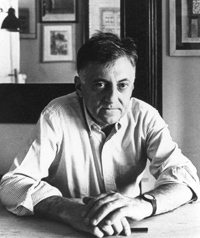Aldo Rossi (Aldo Rossi)

Aldo Rossi began his professional career at the studio of Ignazio Gardella in 1956, moving on to the studio of Marco Zanuso. In 1963 also he began teaching, firstly as an assistant to Ludovico Quaroni (1963) at the school of urban planning in Arezzo, then to Carlo Aymonino at the Institute of Architecture in Venice. In 1965 he was appointed lecturer at the Polytechnic University of Milan and the following year he published The architecture of the city which soon became a classic of architectural literature. His professional career, initially dedicated to architectural theory and small building work took a huge leap forward when Aymonino allowed Rossi to design part of the Monte Amiata complex in the Gallaratese quarter of Milan. In 1971 he won the design competition for the extension of the San Cataldo Cemetery in Modena, which made him internationally famous. After suspension from teaching in Italy in those politically troubled times, Aldo Rossi moved to ETH Zurich, occupying the chair in architectural design from 1971 to 1975.
In 1973 Aldo Rossi was director of the International Architecture Section at the XV Milan Triennial Exhibition of Decorative Arts and Modern Architecture, where he presented, among others, his student Arduino Cantafora. Rossi’s design ideas for the exhibition are explained in the International Architecture Catalogue and in a 16mm documentary Ornament and crime directed by Luigi Durissi and produced along with Gianni Braghieri and Franco Raggi. In 1975, Rossi returned to the teaching profession in Italy, teaching architectural composition in Venice. In 1979 he was made a member of the prestigious Academy of Saint Luke. Meanwhile, there was international interest in his skills. He taught at several universities in the United States, including Cooper Union in New York City and Cornell University in Ithaca (New York State). At Cornell he participated in the Institute for Architecture and Urban Studies joint venture with New York’s Museum of Modern Art, travelling to China and Hong Kong and attending conferences in South America. In 1981 he published his autobiography, A scientific autobiography. In this work the author, “in discrete disorder”, brings back memories, objects, places, forms, literature notes, quotes, and insights and tries to “… go over things or impressions, describe, or look for ways to describe.” In the same year he won first prize at the international competition for the design of an apartment block on the corner of Kochstraße and Wilhelmstraße in central Berlin.
In 1984 together with Ignazio Gardella and Fabio Reinhart, he won the competition for the renovation of the Teatro Carlo Felice in Genoa, which was not fully completed until 1991. In 1985 and 1986 Rossi was director of the 3rd (respectively 4th) International Architecture Exhibition at the Venice Biennale including further away display spaces such as Villa Farsetti in Santa Maria di Sala. In 1987 he won two international competitions: one for a site at the Parc de la Villette in Paris, the other for the Deutsches Historisches Museum in Berlin, which was never brought to fruition. In 1989 he continued product design work for Unifor (now part of Molteni Furniture) and Alessi. His espresso maker La Cupola, designed for Alessi came out in 1988. In 1990 Aldo Rossi was awarded the Pritzker Prize. The city of Fukuoka in Japan honoured him for his work on the hotel complex The Palace and he won the 1991 Thomas Jefferson Medal in Public Architecture from the American Institute of Architects. These prestigious awards were followed by exhibitions at the Centre Georges Pompidou in Paris, the Beurs van Berlage in Amsterdam, the Berlinische Galerie in Berlin and the Museum of Contemporary Art in Ghent, Belgium. In 1996 he became an honorary member of the American Academy of Arts and Letters and the following year he received their special cultural award in architecture and design. He died in Milan on 4 September 1997, following a car accident. Posthumously he received the Torre Guinigi prize for his contribution to urban studies and the Seaside Prize of the Seaside Institute, Florida, where he had built a detached family home in 1995.
On appeal his proposals won the 1999 competition for the restoration of the Teatro La Fenice, Venice and it reopened in 2004. In 1999 the Faculty of Architecture of the University of Bologna, based in Cesena, was named after him. Aldo Rossi won the prestigious Pritzker Prize for architecture in 1990. Ada Louise Huxtable, architectural critic and Pritzker juror, has described Rossi as “a poet who happens to be an architect.”
Born
- May, 03, 1931
- Milan, Italy
Died
- September, 04, 1997
- Milan, Italy



